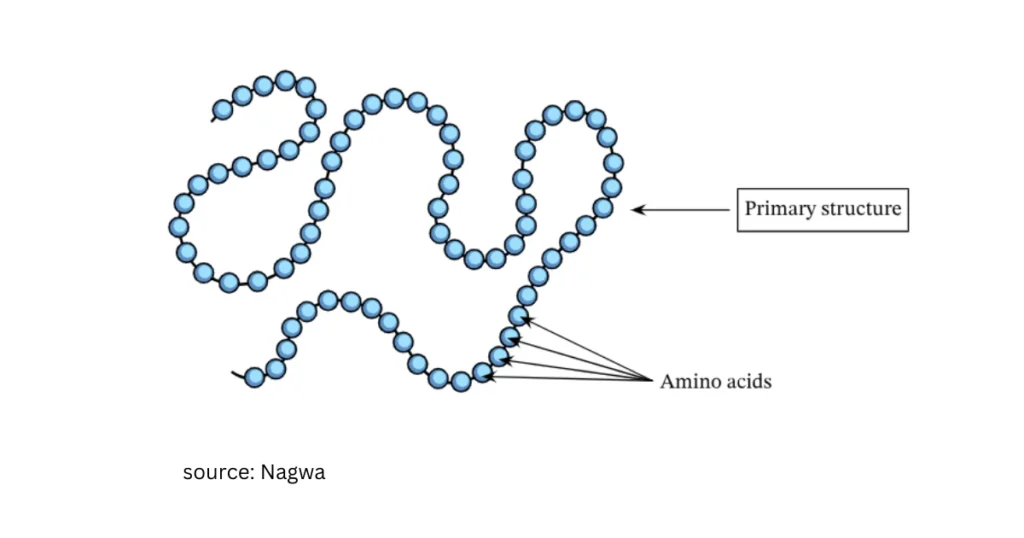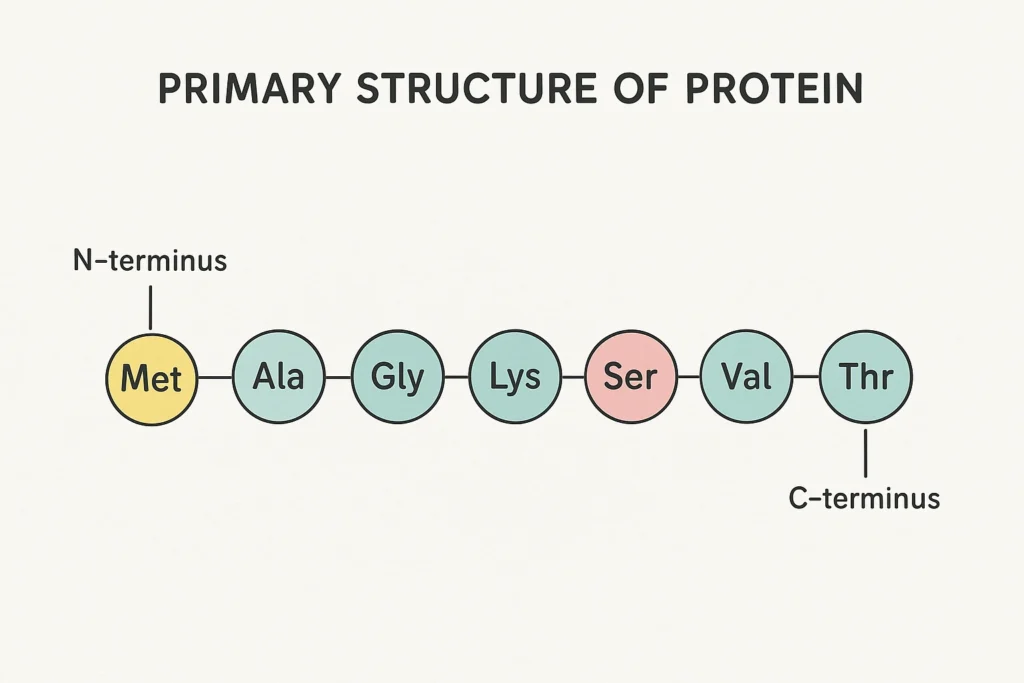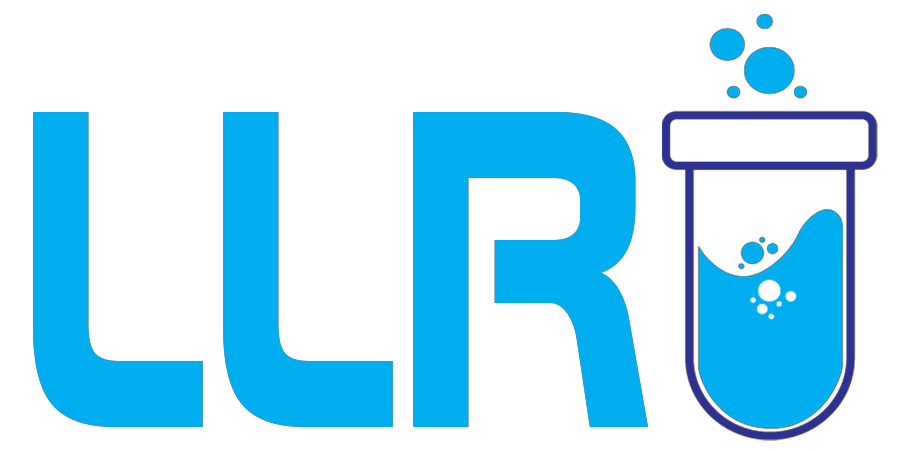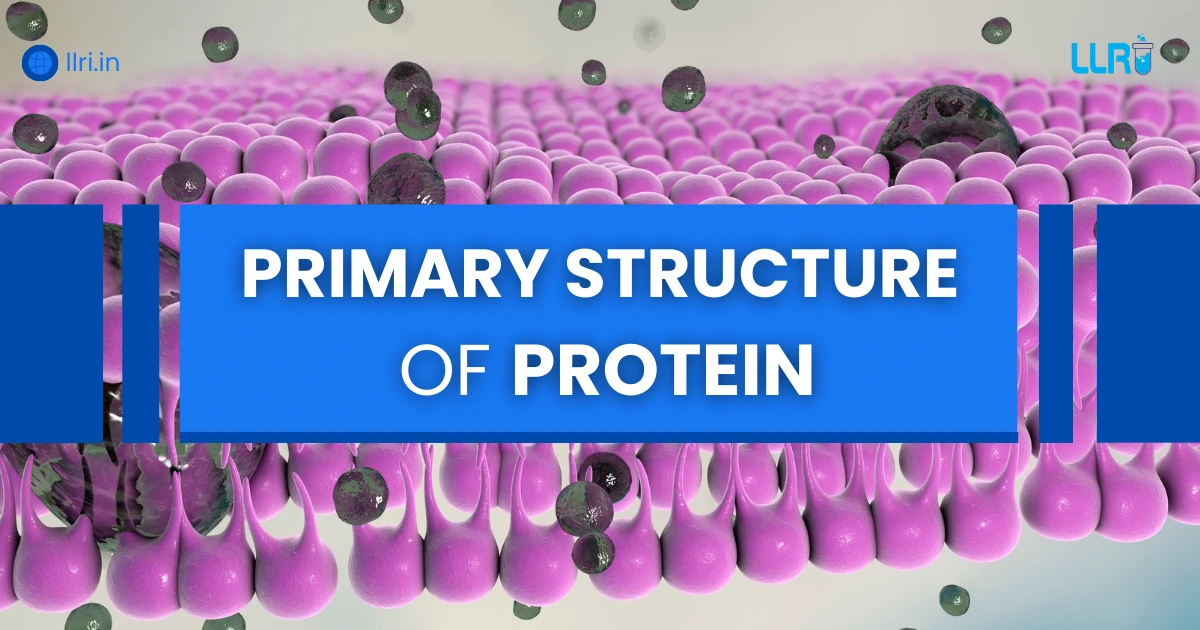Primary Structure Of Protein: “Proteins are the workhorses of life.” This famous line from biochemistry textbooks highlights just how central proteins are to living organisms. From giving structure to our cells, speeding up chemical reactions, transporting oxygen, to defending against diseases, proteins do it all.
But have you ever wondered what gives proteins their unique identity? Why does one protein become an enzyme while another becomes part of muscle fibres? The secret lies in their primary structure of protein.
The primary structure of protein is not just the first step in its hierarchy, it’s the foundation. Without understanding this structure, we cannot truly appreciate how proteins function, fold, or misfold in diseases.
Let’s start at the very beginning.

What is the Primary Structure of Protein?
In the simplest terms, the primary structure of protein refers to the linear sequence of amino acids joined together by peptide bonds.
Each protein is made up of a long chain of smaller units called amino acids. Think of amino acids like the alphabet. Just as different arrangements of letters form different words, different arrangements of amino acids form different proteins.
A protein may contain anywhere from 50 to several thousand amino acids, and even a small change in this sequence can drastically alter the protein’s function.
As the famous molecular biologist Frederick Sanger said (he was the first person to sequence a protein):
“The sequence of amino acids in a protein defines its unique character, just as the sequence of letters defines a word.”
So, the primary structure is essentially a written code, if the code is right, the protein will work properly; if not, problems can arise.
Example of Primary Structure of Protein
Let’s make this clearer with an example of primary structure of protein.
The first protein ever sequenced was insulin, a hormone responsible for controlling blood sugar levels.
- Human insulin consists of 51 amino acids arranged in a specific order.
- If even one amino acid is replaced by another, insulin may not function properly, leading to medical conditions such as diabetes.
For example;
- The normal insulin sequence might read something like: Glycine – Isoleucine – Valine – Glutamine – Tyrosine…
- If Tyrosine is replaced with Phenylalanine at a key position, the protein’s shape and effectiveness change.
This simple example highlights why the primary structure of protein is fundamental.
Primary Structure of Protein Diagram
A primary structure of protein diagram usually shows amino acids linked together by peptide bonds.

Imagine beads on a string:
- Each bead = an amino acid
- The string = peptide bonds
- The order of beads = the protein’s primary structure
In textbooks, the diagram is often represented using the three-letter or one-letter codes of amino acids. For example:
Met – Ala – Gly – Lys – Ser – Val – ThrThis straight-line representation helps us understand how proteins begin, before folding into more complex structures (secondary, tertiary, and quaternary).
Primary Structure of Protein is Due to the Presence of…
So, what holds this chain of amino acids together?
The primary structure of protein is due to the presence of peptide bonds.
- A peptide bond is formed when the carboxyl group (-COOH) of one amino acid reacts with the amino group (-NH2) of another.
- This bond is very strong and does not break easily, which means the primary structure of protein is quite stable.
This stability is essential, because if the sequence changes even slightly, the entire protein may lose its function.
What is the Function of Primary Protein Structure?
You might be wondering, what is the function of primary protein structure? Why do scientists stress on it so much?
The function lies in its role as a blueprint.
- Foundation for Higher Structures
- The primary structure determines how the protein will fold into its secondary (α-helices, β-sheets), tertiary (3D shape), and quaternary (multiple subunits) structures.
- Without the right primary sequence, higher levels cannot form correctly.
- Functional Specificity
- The order of amino acids dictates the protein’s role.
- For example, haemoglobin can bind oxygen only because its sequence ensures the right folding and pocket formation.
- Biological Activity
- Enzymes, antibodies, hormones, all their activities come from their unique amino acid sequence.
To summarise, the function of primary protein structure is to act like a script. The script determines what role the protein will play in the drama of life.
Read More: Let’s Talk DNA: What is the Maxam Gilbert Method of DNA Sequencing?
Why Primary Structure of Protein is Important
Now the big question: why primary structure of protein is important?
Here are some clear reasons:
- Accuracy Matters: A single amino acid change can cause diseases. Example: In sickle cell anaemia, the sixth amino acid in haemoglobin changes from glutamic acid to valine. This tiny shift alters the shape of red blood cells.
- Drug Development: Pharmaceutical scientists’ study primary structures to design medicines. For example, insulin analogues for diabetes are developed by tweaking amino acid sequences.
- Evolutionary Studies: Comparing primary structures of proteins across species helps scientists trace evolutionary relationships.
- Disease Diagnosis: Many genetic diseases are linked to mutations in protein sequences.
As Dr. Linus Pauling once remarked:
“Proteins are the stuff of which life is made, and their sequences are the first words of biology’s language.”
This quote perfectly sums up why primary structure of protein is important, it’s the language life speaks.

Determination of Primary Structure of Protein
Now comes the practical side: determination of primary structure of protein.
Scientists have developed multiple techniques to figure out the amino acid sequence of a protein:
- Edman Degradation Method
- Invented by Pehr Edman.
- Sequentially removes one amino acid at a time from the protein’s N-terminal end.
- Useful for small proteins.
- Mass Spectrometry
- Modern and powerful.
- Breaks proteins into fragments and measures their mass-to-charge ratio.
- Helps determine sequence quickly and accurately.
- DNA Sequencing
- Since DNA codes for proteins, sequencing the gene gives insights into the amino acid sequence.
Each method has its strengths, but together they make determination of primary structure of protein possible in today’s labs.
Let’s recap the journey, shall we?
- The primary structure of protein is the linear sequence of amino acids.
- An example of primary structure of protein is insulin.
- A primary structure of protein diagram shows amino acids linked like beads on a string.
- The primary structure of protein is due to the presence of peptide bonds, which make it stable.
- The function of primary protein structure is to guide folding and activity.
- Why primary structure of protein is important? Because even small changes can cause diseases or open new possibilities in medicine.
- Determination of primary structure of protein is achieved using Edman degradation, mass spectrometry, and DNA sequencing.
On A Final Note…
Learning about the primary structure of protein is like understanding the alphabet before learning to read and write. Without this first step, the higher complexity of proteins would be impossible to grasp.
From insulin to haemoglobin, from enzymes to antibodies, every protein begins with this sequence. And that’s why scientists say: “The sequence tells the story.”
So, next time you hear about a protein, remember, it all begins with the primary structure.
FAQs
Q1. What is the primary structure of a protein?
The linear arrangement of amino acids in a chain, linked by peptide bonds.
Q2. Can you give an example of primary structure of protein?
Yes, insulin is a classic example with 51 amino acids in a precise order.
Q3. What is the primary structure of protein due to the presence of?
It is due to the presence of peptide bonds between amino acids.
Q4. What is the function of primary protein structure?
It provides the blueprint for folding, determines protein function, and ensures biological activity.
Q5. Why primary structure of protein is important?
Because even one amino acid change can lead to diseases like sickle cell anaemia, making it crucial for health and medicine.
Q6. How is determination of primary structure of protein done?
Through Edman degradation, mass spectrometry, and gene sequencing techniques.

